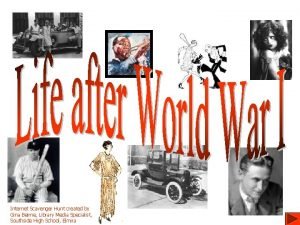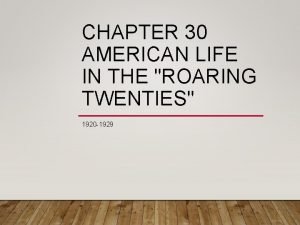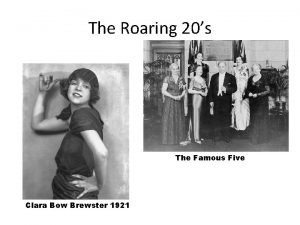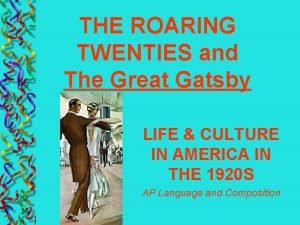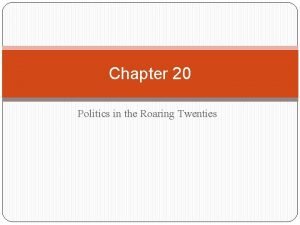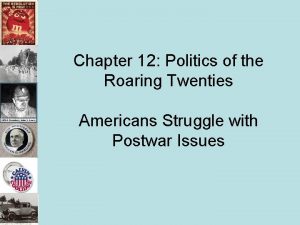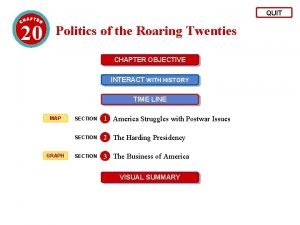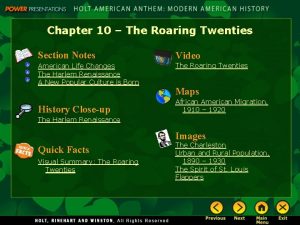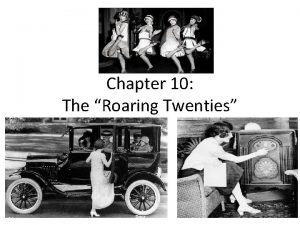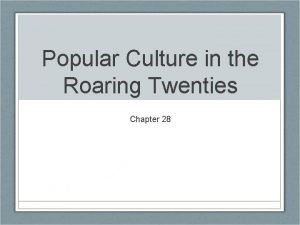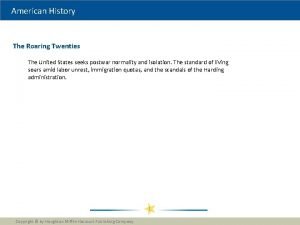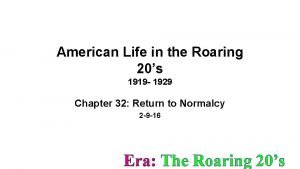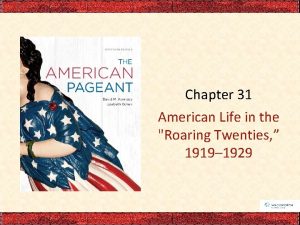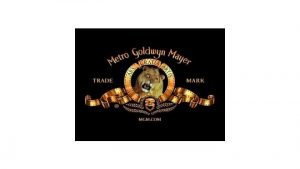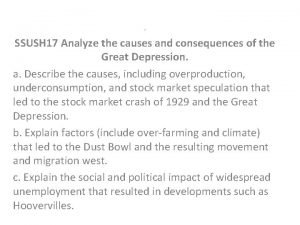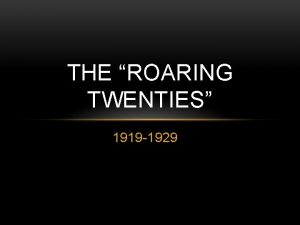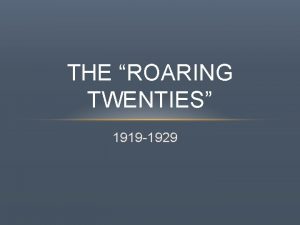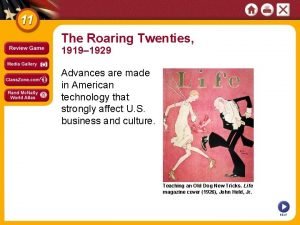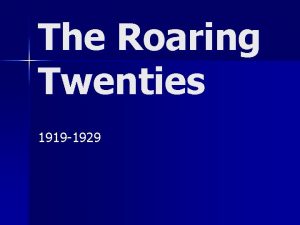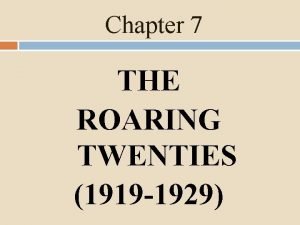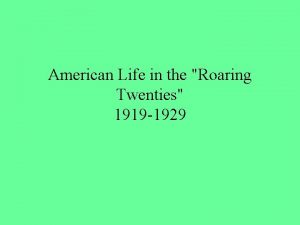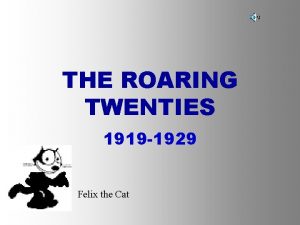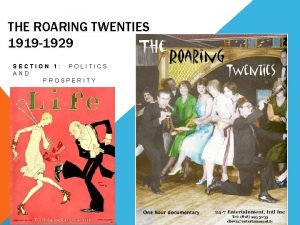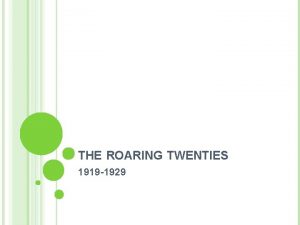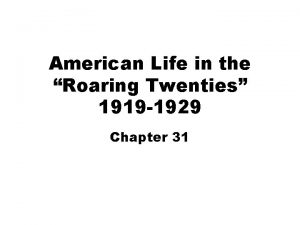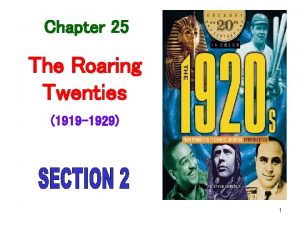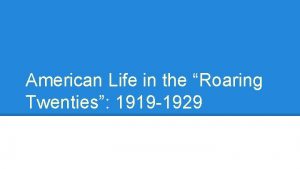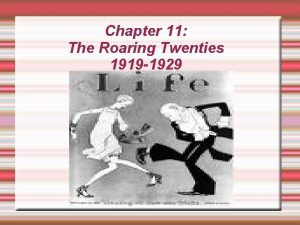THE ROARING TWENTIES 1919 1929 STANDARDS SSUSH 15
















- Slides: 16

THE “ROARING TWENTIES” 1919 -1929

STANDARDS • SSUSH 15 The student will analyze the origins and impact of U. S. involvement in World War I. • d. Describe passage of the Eighteenth Amendment, establishing Prohibition, and the Nineteenth Amendment, establishing woman suffrage. • SSUSH 16 The student will identify key developments in the aftermath of WW I. • b. Identify Henry Ford, mass production, and the automobile. • c. Describe the impact of radio and the movies. • d. Describe modern forms of cultural expression; include Louis Armstrong and the origins of jazz, Langston Hughes and the Harlem Renaissance, Irving Berlin, and Tin Pan Alley.

VOCABULARY • • • mass production-consumer prohibition: suffrage: jazz renaissance

A BOOMING ECONOMY • Henry Ford – car manufacturer who transformed the American production process • Mass Production – rapid manufacture of large numbers of identical products • Model T – first automobile to be widely produced; easily affordable to most American families • Assembly line – arrangement of equipment and workers in which work passes from operation to operation in direct line until the product is assembled.


A BUSTLING ECONOMY • The 1920’s saw a “consumer revolution”- many new, affordable goods became available to the public • Credit extended to more individuals than ever before – “Buy Now, Pay Later!” • Bull Market – period of rising stock prices • Bear Market – period of falling stock prices • Buying on Margin – paying as little as 10% down on stock purchases; $10 could buy $100 of stock

SOCIETY CHANGES AMERICA • Prohibition – banning of alcohol use • Goal of the temperance movement since the mid 1800 s • The 18 th Amendment to the Constitution passed in 1919 forbade the “manufacture, distribution and sale” of alcohol anywhere in the United States • Issue divided the nation, particularly rural and urban Americans • Creation of “speakeasies”- secret bars and nightclubs that illegally served alcohol.



SOCIETY CHANGES AMERICA • 19 th Amendment gives women the right to vote! • Efforts of suffragists like Elizabeth Cady Stanton, Lucretia Mott and Susan B. Anthony finally paid off in 1920 • The importance of women to the war effort during WWI led many to see their vital role in society


RADIO AND MOTION PICTURES REVOLUTIONIZE POPULAR CULTURE - With the boom of the economy, more money flowed into the pockets of everyday citizens. - This extra income allowed Americans to purchase radios and telephones and attend social events and motion picture theaters. - Radios accelerated the development of product commercialism, provided immediate access to breaking news and broadcasts the latest music fads. - Before radio and movies politicians were the celebrities of the day. Now radio personalities, movie stars and athletes become celebrities.

THE JAZZ AGE • How did African Americans express themselves during the early 20 th century? • The Jazz Age – emergence of jazz (a genre of music that combines elements of other styles and emphasizes improvisation) • New Orleans – cultural hearth of Jazz movement • Louis Armstrong – most famous jazz musician of the era

THE HARLEM RENAISSANCE • How did African Americans express themselves during the early 20 th century? • The Harlem Renaissance • “Explosion” of African American poetry, art and literature; centered around the neighborhood of Harlem in New York City • Langston Hughes – most famous African American writer of the era • This increase in African American literature and expression led to a new cultural identity for an entire race. • It exposed white culture to thoughts and feelings of the black community leading to further understanding of racial differences.

TIN PAN ALLEY • Tin Pin Alley – collection of New York music composers and producers who dominated the music industry at the turn of the 20 th century • Piano bars and night time “hot spots” clustered around lower Manhattan in New York City increased demand for newly penned music and lyrics. • Popularity of “Tin Pan” declined with the rise of popular music via radio airplay.

IRVING BERLIN • Irving Berlin • Considered by many to be one of the greatest songwriters of all time. • Penned such classics as: • “Blue Skies” • “White Christmas” • God Bless America”
 Roaring twenties scavenger hunt answers
Roaring twenties scavenger hunt answers Chapter 30 american life in the roaring twenties
Chapter 30 american life in the roaring twenties Roaring twenties acrostic poem
Roaring twenties acrostic poem Roaring twenties great gatsby
Roaring twenties great gatsby Chapter 20 politics of the roaring twenties answer key
Chapter 20 politics of the roaring twenties answer key Politics of the roaring twenties chapter 12
Politics of the roaring twenties chapter 12 Chapter 20 politics of the roaring twenties answer key
Chapter 20 politics of the roaring twenties answer key Chapter 20 politics of the roaring twenties
Chapter 20 politics of the roaring twenties Chapter 10 the roaring twenties answer key
Chapter 10 the roaring twenties answer key Chapter 10 the roaring twenties
Chapter 10 the roaring twenties Chapter 28 popular culture in the roaring twenties
Chapter 28 popular culture in the roaring twenties The roaring twenties lesson 3 changing ways of life
The roaring twenties lesson 3 changing ways of life Roaring twenties acrostic poem
Roaring twenties acrostic poem Chapter 31 american life in the roaring twenties
Chapter 31 american life in the roaring twenties The roaring twenties were characterized by --
The roaring twenties were characterized by -- The roaring twenties canada
The roaring twenties canada Ssush
Ssush
